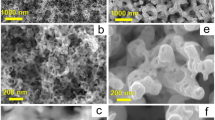Abstract
A model of fuzz formation on a tungsten surface exposed to helium plasma is proposed. According to this model, the fuzz structure forms due to the growth of fuzz fibers from adatoms generated under bombardment by helium ions. The threshold energy of adatom formation by He+ ions is about one-third of the sputtering threshold. The kinetics of adatom diffusion over fibers describes the temporal dependence of the fuzz layer thickness in quantitative agreement with the experiment. In addition to generating adatoms, the role of helium ions consists in the formation of a nonuniform surface as a result of the opening of helium bubbles and, probably, in providing conditions for the aggregation of adatoms over bubbles with extended shells. These factors favor the appearance of clusters that serve as nuclei for the growth of fibers from adatoms and the formation of a fuzz structure.
Similar content being viewed by others
References
S. Takamura, N. Ohno, D. Nishijima, et al., Plasma Fusion Res. 1, 51 (2006).
S. Kajita, W. Sakaguchi, N. Ohno, et al., Nucl. Fusion 48, 095005 (2009).
R. P. Doerner, M. J. Baldwin, and P. Stangeby, in Proceedings of the 14th ITPA Meeting on SOL/Divertor Physics, Seoul, 2010, Paper 10.18-21.
M. Baldwin and R. Doerner, Nucl. Fusion 48, 035001 (2008).
S. I. Krasheninnikov, Phys. Scr. 145, 014040 (2011).
M. I. Guseva and Yu. V. Martynenko, Sov. Phys. Usp. 24, 996 (1981).
V. I. Krauz, Yu. V. Martynenko, N. Yu. Svechnikov, et al., Phys. Usp. 53, 1015 (2010).
Yu. V. Martynenko and M. Yu. Nagel’, Ross. Nanotekhnol. 4(9–10), 59 (2009).
O. Knake and I. N. Stranskii, Usp. Fiz. Nauk 68, 261 (1959).
W. Eckstein, C. García-Rosales, J. Roth, and W. Ottenberger, Technical Report No. IPP-9/82 (Max Planck Institute for Plasma Physics, Garching, 1993).
F. P. Bouden and K. E. Singer, Nature 222, 977 (1969).
M. Yu. Nagel’ and Yu. V. Martynenko, Ross. Nanotekhnol. 6(9–10), 26 (2011).
Author information
Authors and Affiliations
Corresponding author
Additional information
Original Russian Text © Yu.V. Martynenko, M.Yu. Nagel’, 2012, published in Fizika Plazmy, 2012, Vol. 38, No. 12, pp. 1082–1086.
Rights and permissions
About this article
Cite this article
Martynenko, Y.V., Nagel’, M.Y. Model of fuzz formation on a tungsten surface. Plasma Phys. Rep. 38, 996–999 (2012). https://doi.org/10.1134/S1063780X12110074
Received:
Accepted:
Published:
Issue Date:
DOI: https://doi.org/10.1134/S1063780X12110074




